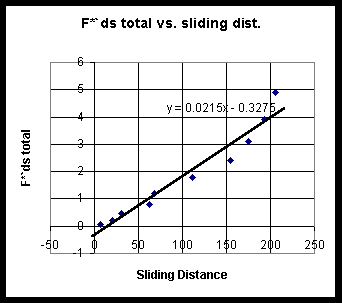Experiment 15 Question(s)
Calculating Approximate Force * Distance
** Note: See also Experiment 10 Question(s)
**
Question (calculating force *
distance):
Below is a table of Rubber band strecth, rail
displacement, and the force.

I am not sure what it is asking to do when it asks to find for each pullback position,
the force * distance total is the total of all force * distance products up to and
including that position. Find the force * distnace total for each position.
Answer:
I assume that your forces were obtained from your calibration of this rubber band.
To calculate Force * Distance products and totals:
- For example, between the 3 cm and 4 cm position
the force exerted by the rubber band averages approximately (.29 N + .39 N) / 2 = .34 N.
- Note: I doubt that you measured the rubber band
stretch to 3 significant figures, so the three apparent significant figures of the force
corresponding to those stretches are not all really significant. Two significant figures
is more appropriate.
- The distance between 3 cm and 4 cm is 1 cm, so the
approximate force * distance for this part of the pullback will be .34 N * 1 cm = .34 N
cm.
-
- Other force * distance products include the
following:
- From 0 to 1 cm the force * distance is
approximately .05 N cm;
- from 1 to 2 cm the product is approximately .15 N
cm;
- from 2 to 3 cm the product is approximately .25 N
cm.
- Thus at the 4 cm position, the approximate
total force * distance will be the total of all these contributions, or
approximately .8 N cm.
I get the graph below for F * `ds total for the rubber band vs. sliding distance.
- This graph appears to be reasonably linear and goes reasonable close to the origin, so
is a reasonable representation of a proportinality.
- The F * `ds total for the sliding rail would be the product of the force F on the rail
and the distance you report. You need to find that force.
- If the force exerted on the sliding rail is constant, then the F * `ds total for the
rubber band should be nearly proportional to the F * `ds total for the sliding rail.
- You still need to find the force to slide the rail, and then to find its F * `ds
total.
- Then you will be able to graph F * `ds for the rubber band vs. F * `ds for the rail.



